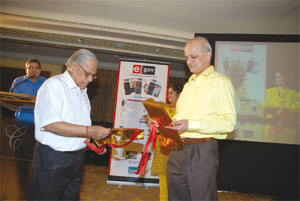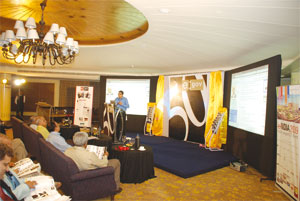 On May 5, 2009, egov magazine celebrated its four year unstoppable journey with the launch of its 50th issue, with special focus in recognition and honour of the contributors in eGovernance ecology in India. The launch of 50th egov magazine and its new web portal, ‘www.egovonline.net’ (beta version) was ceremoniously done by R Chandrashekhar, Special Secretary, Department of IT, Government of India in presence of a gathering with representative from the government, industry, academia, international organisations and civil society, at The Claridges in the Capital.
On May 5, 2009, egov magazine celebrated its four year unstoppable journey with the launch of its 50th issue, with special focus in recognition and honour of the contributors in eGovernance ecology in India. The launch of 50th egov magazine and its new web portal, ‘www.egovonline.net’ (beta version) was ceremoniously done by R Chandrashekhar, Special Secretary, Department of IT, Government of India in presence of a gathering with representative from the government, industry, academia, international organisations and civil society, at The Claridges in the Capital.
Chandrashekhar shared with the audience his association with the magazine. He also shared his thoughts on the journey of egov magazine and fondly recollected the days when the magazine was started, milestones covered, and in the same vein underlined the importance of eGovernance as an initiative in administrative reforms and a tool for citizens empowerment.
While speaking at the launch ceremony, Chandrashekhar tried to bring home the point that a platform for knowledge sharing is as necessary as the need for constant innovation in technology and business processes. Reiterating his opinion on the same, the dignitary said that its in the interest of every one that the departments doing exceptionally well in eGovernance do not become the isolated islands of success and let its experience and knowledge be shared by all. He also elaborated on the importance of civil society as a pressure group and an essential component of the whole system, and said that in creating awareness and enabling capacity building at the end user level, civil societies has a key role to play.

Speaking specifically about the media coverage of events and issues in IT and eGovernance, Chandrashekhar said that firstly, there is lack of a platform where the information on the ICT projects implementation and sustenance from every corner of the country is collated and presented to the masses. Secondly, there is a lack of analyses on the pertinent subject matter in the media. Closely following the space given to the sort of news in most of the publications, one would easily find that news like Satyam get a front page coverage but when the industry crosses 50 billion mark, the news appears in the business page. Naturally it leads to a conclusion that the good news don’t get a mention, as the sensational one does.
Even when the bad news is portrayed, the analyses is not done in the appropriate manner, he added.

Later, a panel discussion on egov magazine: opportunities and challenges and eGovernance as an initiative, chaired by Rajan Verada, Resource Person and National Coordinator, UN Solution Exchange, drew attention on the next step in eGovernance in the country and the challenges lying ahead. Later, initiating the panel discussion, Rajan expressed his concerns over the challenges in the implementation of eGovernment projects. Replying to his concerns, Sudhir Aggarwal, senior vice president, government initiatives, Sify said though the vertical connectivity has been achieved in most part of the country, horizontal connectivity is still a major concern hampering ICT inclusion in many states. Besides, he also drew the point that huge amount of money is being put to enable eGovernment in the country, but there is little being done on the regulatory front. Concluding his remarks, Aggarwal said that administrative and regulatory reforms are the needs of the hour, besides the integration of offices and businesses from not only top to bottom level but also at horizontal level.
Rashmi Kaushik, professor, Management and Development Institute, Gurgaon emphasised on the need of the stakeholder consultations and pointed that unless that happens the ownership will not come. Also, she particularly referred to the urgency of horizontal connectivity and said the fruits of these eReforms can be reaped only after every department in a state is fully integrated with the other. Further, she added that the emphasis should be laid on evaluation of the eGovernance projects and put forth an advise to measure the level of government process re-engineering in the evaluation process.
Ashish Sanyal, Senior Director, DIT, said that the Phase I of the eGovernment implementation saw laying of the information and communication technology infrastructure and digitisation of records and putting in place computing devices and tools. Now in second phase, he added, change management and business process re-engineering are to be religiously pursued. Simultaneously, he also stressed on the need for synchronisation of implementation of projects from IT Secretary office.
Chipping in to the discussion, Shashank Ojha, senior eGovernment specialist, eGovernment Practice- ISG, World Bank, swiftly pointed towards the need to have a policy on ICT in health and education. He also referred to the lack of industry solutions in to field of health and education. Besides commenting on the vitality of the business continuity, Ojha articulated on the the need to create a community, which can withstand the pressure from every corner and take the lead to the successful implementation of the projects.
Elaborating on the significance of accountability, Jaijit Bhattacharya, country director- government strategy, Sun Microsystems said the discretionary power needs to be codified before setting up of an accountability mechanism. Corroborating further, he said that while analysing the failure of eGovernance projects, one must pay heed to the causes of failure of a project and figure out that if the failings are at the political level or at the bureaucratic level. Thus, he added, one should redefine the definition of failure.
Interestingly, Bhattacharya further spoke on the long term sustainability model required by the eGovernance initiatives and pointed towards the energy requirement of the ICT in the country. He said: Last year 7.5 million personal computers were in India. Considering the fact that a single PC takes around 200 Watt of power, the amount of power required by the ongoing eGovernance projects would be nearly 1.5Gigawatt and that is the amount generated by three nuclear power plants. So the question is the sustainability of these projects.
Commenting on the popular phrases like ‘India, a graveyard of pilot projects’ and ‘more pilots but less roll outs’ Ravi Gupta, Editor-in-Chief, egov linked the failure of some projects to the Indian mythology of ‘re-birth’ and said that after death, humans are born again and like wise the projects like ‘Gyandoot’ in Madhya Pradesh and many of eGovernance projects by Media Lab Asia which ultimately disappeared but later same people came up with another more lucrative project, popular as DRISHTI.
 Further, he firmly stated his optimistic view on the ongoing eGovernance drive in the country and said that the drive for ICT penetration would withstand the pressure from corners and fetch results for the society as a whole.
Further, he firmly stated his optimistic view on the ongoing eGovernance drive in the country and said that the drive for ICT penetration would withstand the pressure from corners and fetch results for the society as a whole.
After the floor was thrown open to the Q & A session, a former Director General of Police was prompt to ask a question from the learned panelists if it was possible to frame a anti-corruption mechanism through ICT so that major portion of the developmental allocations could reach to the targeted beneficiaries. Responding to the DGP’s concern, Aggarwal suggested for setting up of a citizen dash board where a system can be developed to pull data on various governmental schemes and programmes so as to know how much portion of the total allocation has been so far utilised in project implementation and in what manner.
Moreover, he added, the issue can be addressed through pro active mechanism – providing all these relevant information on required government websites- and rather than using of Right to Information for the same, which is a reactive mechanism.
Adding to the response to the measures to reduce corruption, Battacharya said that it is important to codify the discretionary power at various levels in the government bodies,so that the involvement and accountability of public officials can be made clearer. On the same, Sanyal was of view that a solution can be evolved through focusing more on the the business process re-engineering. Ojha discussed the hurdles in eradicating corruption and successfully implementing eGovernance projects that included: business continuity, top-down approach where the person sitting at the top drives the implementation to the lowest level and the failure to generate a demand driven approach where citizens demand for certain modifications in services and as result the applications are put in place as in the case of e-Commerce, core banking system (CBS) etc. He pointed out that the lack in technology and applications are not the hurdles as such but it is the lack of above mentioned factors that are the real impediments.
While articulating his opinion on successful implementation of ICT projects, Rajen said that standards for evaluating ICT projects should be evolved and uniformly followed by the various government bodies, which subsequently will lead to setting up of set of bench marks for successful project implementation and sustenance.
The panel ended up with some very useful conclusions for the effective implementation that included creation and following of best practices, impact assessment of eGovernance projects, expanding and measuring government process re-engineering, speedy change management, strong regulatory framework to ensure compliance with global standards and transparency level and ultimate inclusion of eGovernance into governance so that it is the default mode of governance and not a special are to be focused on, since the ICT4D is not an end in itself but a means for good governance.
For egov (magazine), the panel and as well some speakers form the audiences suggested some key and unparalleled themes which included: to come up with an issue in Hindi and later in other regional languages, focus on impact assessment, inclusion of developments at the grassroots level, a citizen forum for discussion and debate on eGovernance issues. 
Be a part of Elets Collaborative Initiatives. Join Us for Upcoming Events and explore business opportunities. Like us on Facebook , connect with us on LinkedIn and follow us on Twitter, Instagram.











